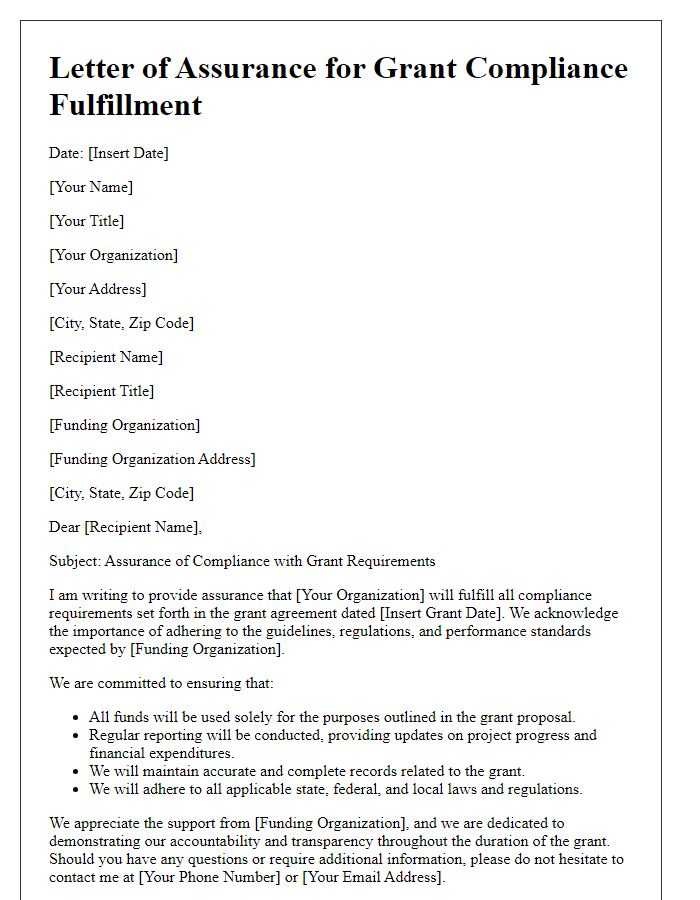When it comes to securing funding for your projects, ensuring compliance with grant regulations is paramount. This process can often seem overwhelming, but with the right approach, it becomes manageable and straightforward. A well-crafted letter confirming grant compliance not only demonstrates your commitment to following guidelines but also strengthens your relationship with funding organizations. Ready to dive deeper into creating the perfect compliance confirmation letter? Keep reading!

Organization Details
The organization details for grant compliance confirmation include essential information about the entity receiving the funding. The organization typically consists of the official name (e.g., "Green Future Initiative"), the registered address (e.g., "123 Environmental Road, Springfield, IL"), the Tax Identification Number (TIN or EIN, such as "12-3456789"), and the main contact person (e.g., "Jane Doe, Program Director"). This confirmation should highlight the organization's mission, which often aligns with the grant's objectives, such as environmental sustainability or community development. Furthermore, the organization should include its registration status (e.g., 501(c)(3) nonprofit status) and any relevant certifications or affiliations (such as being part of local or national environmental networks) that validate its compliance for the grant requirements.
Grant Details
Grant compliance confirmation entails verifying adherence to guidelines established by funding entities, such as the National Institutes of Health (NIH) or the National Science Foundation (NSF). Compliance involves ensuring all project expenditures align with the approved budget (detailing amounts allocated for personnel, equipment, and supplies), maintaining accurate records of all activities undertaken within the project's timeline (often spanning 1 to 5 years), and submitting required reports (progress reports, financial statements) by specified deadlines. Documentation should reflect both qualitative and quantitative outcomes, demonstrating the efficacy of funded activities and overall impact on the research community or targeted demographic (for example, underserved populations or technological advancements). Regular audits by external reviewers may be included to assess adherence, ensuring that grant objectives align with compliance standards imposed by regulatory agencies.
Compliance Statement
Compliance statements are essential documents that confirm adherence to regulations and guidelines set forth by funding agencies or organizations. These statements typically outline the recipient's commitment to uphold ethical standards, financial accountability, and adherence to specific project timelines. For example, in research grants administered by the National Institutes of Health (NIH), compliance includes assurance of meeting Institutional Review Board (IRB) requirements for human subject research, adhering to the established budgetary constraints, and following reporting protocols. Effective compliance statements help establish transparency and build trust between grant recipients and funders, ensuring that allocated resources are used responsibly for intended purposes.
Supporting Documents
Grant compliance confirmation requires a comprehensive review of supporting documents such as financial statements, programmatic reports, and evaluation metrics. These documents provide essential evidence, ensuring alignment with funding agency requirements, notably 2 CFR 200.300 (Uniform Guidance). Each financial statement must clearly detail expenditures, matching the budgetary allocations submitted in the initial grant proposal. Programmatic reports outline project progress, including key performance indicators (KPIs) established during the grant initiation phase. Evaluation metrics assess the effectiveness of the funded activities, providing a quantitative measure of success. Timely submission of these documents, typically due quarterly or biannually as specified in the grant agreement, upholds accountability and transparency in the utilization of grant funds.
Contact Information
Contact information serves as a critical component for grant compliance confirmation. Complete details, including full name, organization title, mailing address, and email address, provide essential clarity for correspondence. For example, a typical mailing address in the United States might include a street address, city, state abbreviations (like CA for California), and a ZIP code (such as 90210), ensuring proper delivery. Email addresses should utilize professional domains, enhancing credibility (e.g., john.doe@organization.org). Furthermore, phone numbers, formatted with country codes (like +1 for the United States) followed by the area code, facilitate direct communication regarding grant inquiries or compliance issues. This comprehensive contact information streamlines the verification process, helping maintain accountability and transparency in grant management.
















Comments